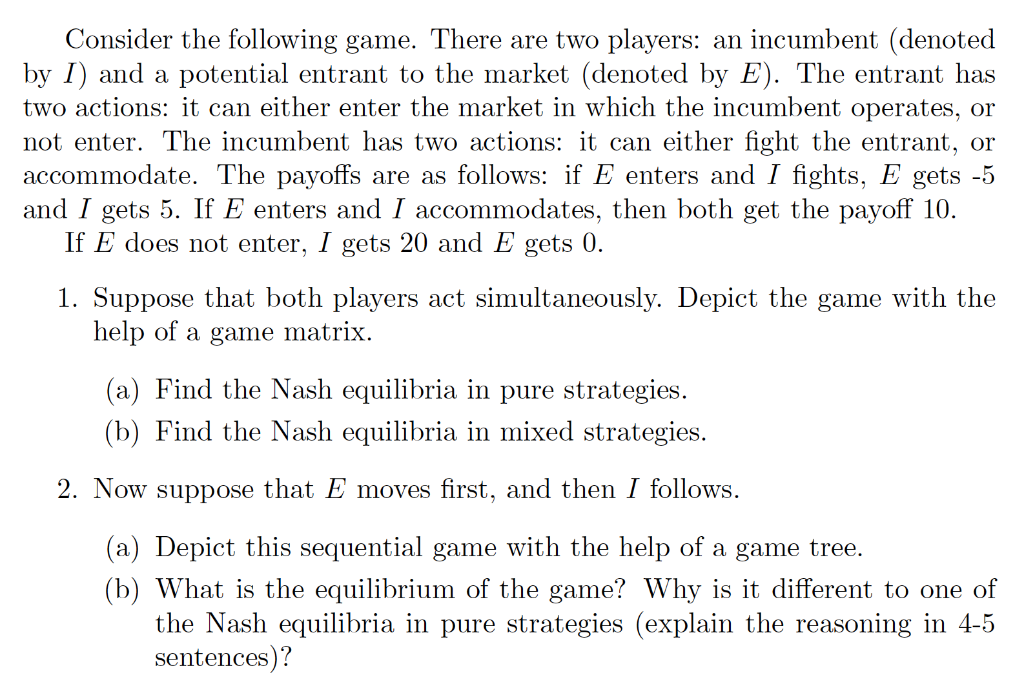Consider the following game. There are two players: an incumbent (denoted by I) and a potential entrant to the market (denoted by E). The entrant has two actions: it can either enter the market in which the incumbent operates, or not enter. The incumbent has two actions: it can either fight the entrant, or accommodate. The payoffs are as follows: if E enters and I fights, E gets -5 and I gets 5. If E enters and I accommodates, then both get the payoff 10. If E does not enter, I gets 20 and E gets 0. 1. Suppose that both players act simultaneously. Depict the game with the help of a game matrix. (a) Find the Nash equilibria in pure strategies. (b) Find the Nash equilibria mixed strategies. 2. Now suppose that E moves first, and then I follows.
Consider the following game. There are two players: an incumbent (denoted by I) and a potential entrant to the market (denoted by E). The entrant has two actions: it can either enter the market in which the incumbent operates, or not enter. The incumbent has two actions: it can either fight the entrant, or accommodate. The payoffs are as follows: if E enters and I fights, E gets -5 and I gets 5. If E enters and I accommodates, then both get the payoff 10. If E does not enter, I gets 20 and E gets 0. 1. Suppose that both players act simultaneously. Depict the game with the help of a game matrix. (a) Find the Nash equilibria in pure strategies. (b) Find the Nash equilibria mixed strategies. 2. Now suppose that E moves first, and then I follows.
Chapter8: Game Theory
Section: Chapter Questions
Problem 8.7P
Related questions
Question
5

Transcribed Image Text:Consider the following game. There are two players: an incumbent (denoted
by I) and a potential entrant to the market (denoted by E). The entrant has
two actions: it can either enter the market in which the incumbent operates, or
not enter. The incumbent has two actions: it can either fight the entrant, or
accommodate. The payoffs are as follows: if E enters and I fights, E gets -5
and I gets 5. If E enters and I accommodates, then both get the payoff 10.
If E does not enter, I gets 20 and E gets 0.
1. Suppose that both players act simultaneously. Depict the game with the
help of a game matrix.
(a) Find the Nash equilibria in pure strategies.
(b) Find the Nash equilibria in mixed strategies.
2. Now suppose that E moves first, and then I follows.
(a) Depict this sequential game with the help of a game tree.
(b) What is the equilibrium of the game? Why is it different to one of
the Nash equilibria in pure strategies (explain the reasoning in 4-5
sentences)?
Expert Solution
This question has been solved!
Explore an expertly crafted, step-by-step solution for a thorough understanding of key concepts.
Step by step
Solved in 2 steps

Knowledge Booster
Learn more about
Need a deep-dive on the concept behind this application? Look no further. Learn more about this topic, economics and related others by exploring similar questions and additional content below.Recommended textbooks for you


Principles of Microeconomics (MindTap Course List)
Economics
ISBN:
9781305971493
Author:
N. Gregory Mankiw
Publisher:
Cengage Learning

Principles of Economics (MindTap Course List)
Economics
ISBN:
9781305585126
Author:
N. Gregory Mankiw
Publisher:
Cengage Learning


Principles of Microeconomics (MindTap Course List)
Economics
ISBN:
9781305971493
Author:
N. Gregory Mankiw
Publisher:
Cengage Learning

Principles of Economics (MindTap Course List)
Economics
ISBN:
9781305585126
Author:
N. Gregory Mankiw
Publisher:
Cengage Learning

Principles of Economics, 7th Edition (MindTap Cou…
Economics
ISBN:
9781285165875
Author:
N. Gregory Mankiw
Publisher:
Cengage Learning

Exploring Economics
Economics
ISBN:
9781544336329
Author:
Robert L. Sexton
Publisher:
SAGE Publications, Inc

Microeconomics: Principles & Policy
Economics
ISBN:
9781337794992
Author:
William J. Baumol, Alan S. Blinder, John L. Solow
Publisher:
Cengage Learning